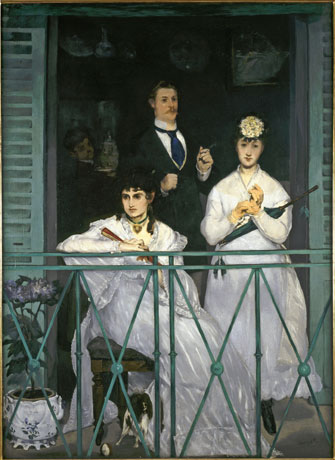Dressing to Kill for the
Impressionists

Renoir’s ”Jeune Femme à la Voilette” (1870). © Musée d’Orsay. RMN/Patrice Schmidt
The title of the exhibition “Impressionism and Fashion” at the Musée d’Orsay may be off-putting to those who have little or no interest in fashion, but this beautifully put-together show uses the theme of clothing as a good excuse for bringing together a number of masterpieces that will please any art lover.
The period clothing on display is an extra bonus that can’t help but be interesting, especially when the actual dress worn in a painting is shown next to it, as in “Dans la Serre” (1881), by Albert Bartholomé. The purple-and-white dress, faithfully reproduced in the painting, combines an amazing number of patterns and techniques – stripes, dots, bows, tiny pleats – into a coherent garment that doesn’t seem busy at all. One can only admire its anonymous designer (and the painter).
Manet is the star of the show, with, among others, his famed “Le Balcon” (1868-69), in which the three protagonists on the balcony

Manet’s “Le Balcon” (1868-69). © RMN Musée d’Orsay/Hervé Lewandowski
ignore each other against the mysterious background of the shadowy interior. The label (the show’s labels are not only full of lively, interesting information about each work, but are also, for once, translated into English!) tells us that Manet made a couple of wardrobe errors in this picture: one of his models, Berthe Morisot (on the left), is wearing a housedress in public, while the other, Fanny Claus, umbrella in hand, is all dressed up to go out.
Manet is well supported by a large cast of Impressionists. Monet is here with a lovely full-length portrait of Madame Louis Joachim Gaudibert (1868), a rare non-Impressionist work, painted indoors, and his version of “Le Déjeuner sur l’Herbe” (1865-66).
Renoir, of course, pops up over and over, and several of the works here are more interesting than much of his later work, perhaps because they look closely at the particular rather than just offering fuzzy, generic pictures of pretty girls; an example is “Portrait de Madame Charpentier et de Ses Enfants” (1878), in which the two children’s matching dresses are lovingly depicted, as is the long-suffering black-and-white dog one of the children is sitting on. I also very much liked his mysterious “Jeune Femme à la Voilette” (1875, pictured above), with her veiled face and plaid wrap.
There are quite a few paintings in the show by James Tissot, who, while not as talented as his contemporaries Monet and Manet, offers us almost photographic images of life at the time. Another artist whose works have documentary value is Jean Béraud; Proust-lovers will immediately recognize the type of gathering depicted in his “La Soirée” (1878).
The great fascination of all these male painters with the details of women’s clothing is not really surprising when you think of the attention paid to dress by the Dutch masters, for example.
The female Impressionists, of course, also paid close attention to their subjects’ clothing and are represented in the show with some marvelous works. One I found fascinating was Berthe Morisot’s “L’Intérieur” (1872), with its three distinct worlds. On the light-filled left side, all white and pink, a young woman and a girl look out through a white-curtained window. The picture is divided in the center by another young woman, all in black, sitting pensively in profile, her hands folded in her lap. On the right, nature intrudes into the apartment in the form of a big, ornate planter overflowing with spiky plants and flowers.
In “Dans la Loge” (1878), another female Impressionist, Mary Cassatt, seems less interested in fashion than social interaction, as the main figure, a woman in black, intently scans the theater’s audience with her opera glasses, while she in turn is observed by others through their glasses, another scene that will be familiar to Proustians.
Eva Gonzalès takes a head-on look at the inhabitants of a box at the opera in “Une Loge aux Italiens” (c. 1874), and zeroes in on ladies’ shoes in the gorgeous “Souliers Roses, (1879-80), or “Pink Shoes.”
This is an equal-opportunity exhibition, with a section devoted to men’s wardrobes of the period. Here we are treated to Henri Fantin-Latour’s portrait (1867) of the red-headed dandy Edouard Manet and Gustave Caillebotte’s wonderful “Au Café” (1880), in which an ordinary guy in a purplish jacket and rumpled trousers leans nonchalantly against a table, while two seated men on deep-red banquettes are seen in a mirror behind him and a window offers a glimpse of the world outside.
Try not to miss this excellent show, with its extravagant mise en scène: huge mirrors reflect large-format paintings, and rows and rows of little gilded, red-velvet-upholstered chairs (you can even sit on them!) are hung with name tags of literary and artistic luminaries of the period.
The only pity is that the exhibition is so packed with visitors. We tried going at the end of the day, but even then there was an overflow crowd.
Musée d’Orsay: 1, rue de la Légion d’Honneur, 75007 Paris. Métro: Solferino. RER: Musée d’Orsay. Tel.: 01 40 49 48 14. Open Tuesday-Sunday, 9:30 a.m.-6 p.m., until 9:45 p.m. on Thursday. Closed Christmas Day and New Year’s Day. Admission: €12. Through January 20, 2013. www.musee-orsay.fr
Reader Charlene Moyer writes: “In the painting ‘Madame Charpentier et Ses Enfants,’ the child sitting next to her is her son, Paul. He was three years old, and had not as yet had his hair cut. He is wearing the same dress as his older sister.”
Reader reaction: Click here to respond to this article (your response may be published on this page and is subject to editing).
Please support Paris Update by ordering books from Paris Update’s Amazon store at no extra cost. Click on your preferred Amazon location: U.K., France, U.S.
More reviews of Paris art shows.
© 2012 Paris Update
